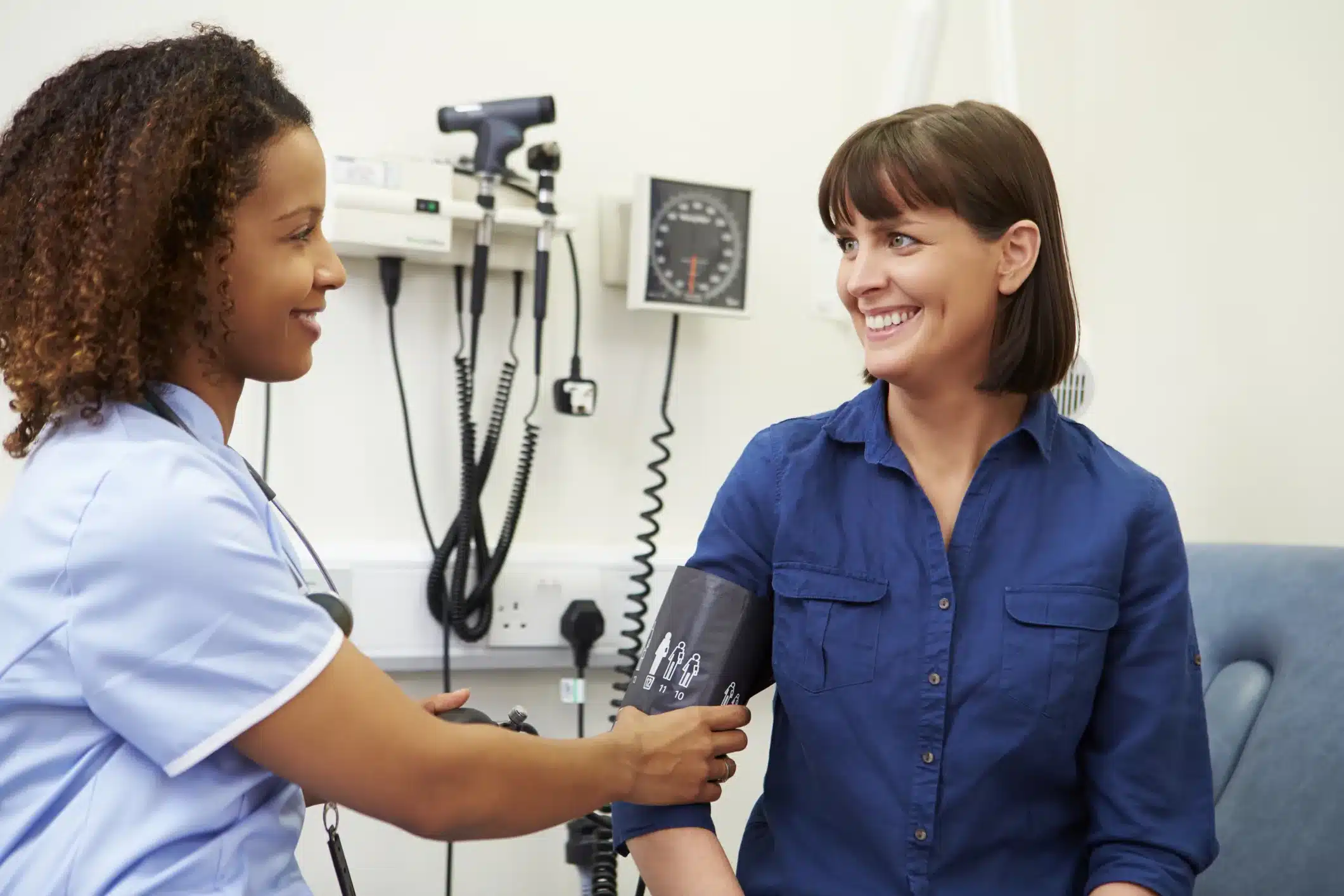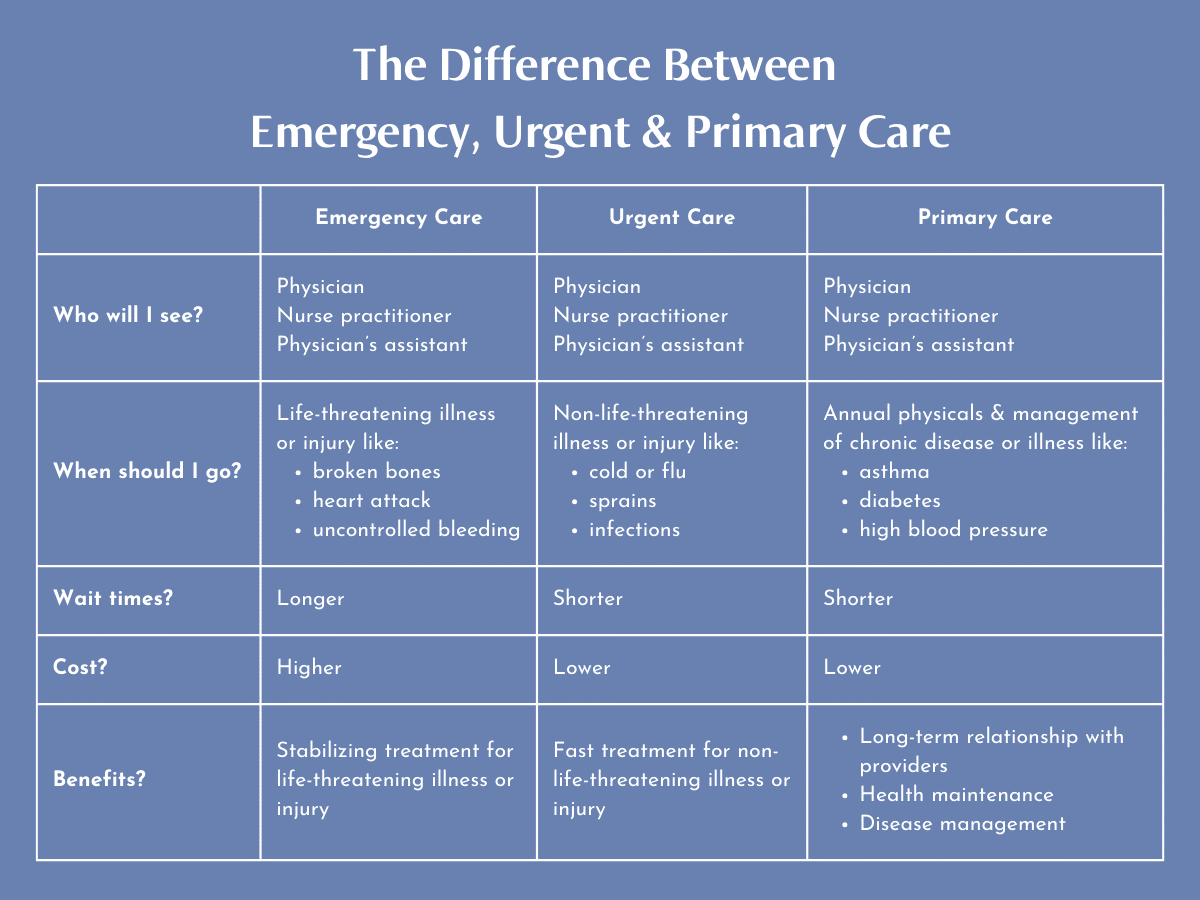
With all the healthcare options out there, it can be hard to figure out what kind of care you need. Do you need to go the emergency room or urgent care for that twisted ankle? Is that nasty cough better treated at primary care or urgent care? Read on to find out the differences (and similarities) in emergency, urgent and primary care.
What’s NOT Different?
Whether you seek emergency, urgent or primary care, you may see a doctor, nurse practitioner or physician’s assistant. They are all licensed healthcare professionals with specialized training to provide medical care and work across all healthcare fields. At a clinic or E.R., you should experience the same level of care.
What’s Different?
The main difference between emergency, urgent and primary care is the type of health conditions they can treat. Additional differences include the cost and the wait time you might expect. We’ll examine each option and share when and where you should seek care.
Emergency Care
Emergency care services are delivered in hospitals by emergency departments. Hospital emergency rooms are open 24 hours a day, seven days a week. They are prepared with specialized training and equipment to treat critically ill and injured patients.
Emergency rooms do not take appointments. If you visit the same emergency room multiple times, you will likely see different providers each time. Their focus is to stabilize your health issue and then either:
- Admit you to the hospital if your condition requires admission or
- Discharge you from the emergency room with instructions to follow up with your primary care provider or a specialist.
When Should I Go to the Emergency Room?
You should visit the emergency room if you are experiencing a life-threatening or life-altering health condition. Some examples include:
- Amputations
- Bloody diarrhea or vomiting
- Chest pain or heart attack
- Difficulty breathing
- Extreme burns
- Fever over 103 degrees
- Mental health crisis
- Numbness or weakness on one side of the body
- Open fractures or broken bones
- Rash with a fever
- Severe abdominal pain
- Severe dizziness
- Slurred speech
- Sudden loss of vision or onset of blurred or double vision
- Uncontrolled bleeding
- Vaginal bleeding during pregnancy
If you are experiencing any of these symptoms, call 911 or go to the nearest emergency department for care.
Emergency Wait Times and Cost
If you’ve been to an emergency department recently, you know they are overcrowded. Over the last decade, emergency room visits have increased while the number of emergency rooms in communities has decreased. Additionally, there is a national shortage of healthcare staff, so many emergency rooms are understaffed.
Emergency departments do not see patients on a first-come, first-served basis. They must provide emergent care to the sickest patients first, which makes it difficult to estimate wait times. Critically ill and injured patients may require an enormous amount of time and staff to stabilize them. Plus, there is no way to know when another critically ill or injured patient may arrive.
Patients may arrive as walk-ins or by ambulance with emergency medical services (EMS) personnel. It does not matter how you arrive; all patients are treated based on the severity of their medical condition. Less acutely ill patients who arrive by ambulance may be sent to the waiting room.
Emergency care is more expensive than urgent care or primary care. Most insurance coverage will require a higher copay for emergency care services.
Urgent Care
Urgent care services are delivered at urgent care clinics by licensed medical professionals. Many urgent care clinics offer extended hours of operation, and some are open seven days a week for your convenience. They are prepared to treat minor illnesses and injuries with on-site lab testing and x-ray imaging.
Some urgent care centers are walk-in clinics, some take appointments or online registration, and some accept both. They focus on quickly addressing your illness or injury and getting you back to your daily routine and responsibilities.
When Should I Go to Urgent Care?
You should visit an urgent care clinic if you are experiencing a non-life-threatening illness or injury and need to be seen quickly. Some examples include:
- Abdominal pain
- Allergies and asthma
- Cold and flu symptoms
- Cuts and lacerations with controlled bleeding
- Earaches
- Headaches and migraines
- Insect bites
- Joint pain, sprains, strains, and twists
- Minor burns and sunburn
- Nausea, vomiting, and diarrhea
- Rashes
- Sore throat
- Sports injuries
- Urinary tract infections
Check out MainStreet Family Care for a more comprehensive list of life’s little emergencies we’re here to help you with!
Urgent Care Wait Times and Cost
More urgent care clinics are opening in communities to relieve the burden of overcrowding in emergency rooms and decrease the cost of healthcare for patients.
The wait time for urgent care is much shorter than that for emergency rooms. Some urgent care clinics, like MainStreet Family Care, allow you to register online. This reduces your in-clinic wait time by waiting at home until it’s time to head to the clinic.
Insurance copayments for urgent care are often much lower than those for emergency rooms. Some insurance copayments for urgent care are similar to primary care copayments. Check with your health insurance provider to find out more about your plan’s copayment structure.
Primary Care
Primary care services are delivered at various locations, including small private doctor’s offices, large hospital-affiliated primary care groups, and primary care clinics. Primary care doctors usually have office hours Monday through Friday. However, some have extended days and hours now—MainStreet Family Care offers primary care services seven days a week!
Primary care providers may treat you for minor illnesses, but they focus on your overall health. They do this by promoting a healthy lifestyle to prevent disease and manage chronic conditions you may have. Most primary care facilities require appointments. Primary care has many benefits, but the biggest is establishing a long-term relationship with trusted healthcare providers who know your health history.
When Should I Go to Primary Care?
You should visit your primary care provider at least once a year for an annual physical, even if you’re in good health. These appointments establish your baseline health and monitor any changes through the years. Your primary care physician will talk with you about any health concerns, perform a physical exam, and run lab tests to check for any indications of disease or illness. They will also keep you on track for age-related exams and procedures like mammograms, prostate exams and colonoscopies.
You should see a primary care provider more frequently if you have a chronic disease or risk factors for chronic disease, such as:
- Acid reflux (GERD)
- Asthma
- Chronic Obstructive Pulmonary Disease (COPD)
- Diabetes
- High blood pressure
- High cholesterol
- Obesity
- Thyroid disorders
Your primary care provider can manage your medications and refer you to specialists for some health conditions as needed.
Primary Care Wait Times and Cost
The wait times for primary care are usually short because you have made an appointment. The insurance copay requirements for primary care services are generally lower because insurance companies encourage health maintenance and management. Some health insurance policies may cover annual physical exams with no copayment as an incentive to maintain good health.
Summarizing the Differences
Here is a summary of the differences between emergency, urgent, and primary care at a glance:

Turn to MainStreet Family Care
Have an urgent, non-life-threatening health concern? MainStreet Family Care urgent care services can help you feel better fast!
Register online for an appointment to reduce in-clinic wait times. You can wait from the comfort of your home or car until we’re ready to see you. We’ll text you when it’s time to head to the clinic.
Looking for primary care services? MainStreet Family Care clinics have you covered! We offer primary care services, often with same-day or next-day appointments available, and we’re open seven days a week!
Register online for a primary care patient portal account and schedule an appointment through your patient portal.






